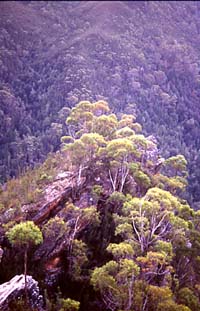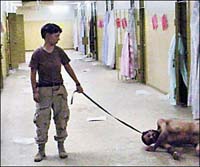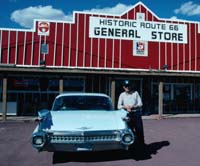Causes & Concerns
Saturday, 10 December 2005Things I worry about from old growth forest destruction in the Australian state of Tasmania to what Amnesty International has rightly described as ‘a human rights scandal’ in, where else, Guantanamo Bay.
Marshalls Shoot & Kill Passenger
US Newspaper headline 8 December 2005
Rigoberto Alpizar, a passenger on an American Airlines flight about to depart Miami was shot and killed by ‘sky marshalls’, the armed personnel said to be on many flights to, from or within the USA.
Am I more concerned about flying today, with the constant publicity about terrorism?
Usually I’d say not at all, and in most places I don’t need to be, but it’s clear I should be worried on any American airline or flying to or from the US with these trigger happy gunpersons on board. Remember they’re trained by the same people who identified all those imaginary WMDs.
 Bloodthirsty Countries
Bloodthirsty Countries
The impending execution of Nguyen Tuong Van, a young Australian of Vietnamese descent, has focussed attention again on Singapore’s truly amazing rate of executions. When we talk about enthusiastic use of the death penalty China and the USA are the places we usually think about. There is no question that China dispatches more of its citizens than any other country on earth. The annual kill rate is at least 3,500, but then China has an awful lot of people to choose from, 1.3 billion of them at last count. In comparison the USA is a non-starter: Vietnam, Iran and Saudi Arabia all out-kill the USA and on a per capita basis they’re way ahead.
Singapore leaves them all in the dust. The squeaky clean city state is not just secretive about its execution figures it’s positively vague. When Prime Minister Goh Chok Tong was asked by the BBC in September 2003 why he didn’t know the precise number of people executed (his guess was 70 or 80 when the actual figure that year was closer to 10) he replied that he had ‘more important things to worry about.’
In fact Singapore sent 400 people to the hangman between 1991 and 2003. That’s about 30 a year, in comparison the US executes twice as many, about 60 a year, but has a population 70 times as great!
In Singapore you can meet the hangman for not just murder but also for kidnapping, drug trafficking and treason. Nguyen Tuong Van was arrested at Singapore’s Changi Airport in 2002 with 400 gm of heroin. He was not attempting to smuggle the drug in to Singapore, he was in transit to Australia. He was 22 years old.
Using execution figures from Amnesty International here’s the story:
1. USA – 300 million people – 60 executions per year = 20 per 100 million
2. Vietnam – 80 million people – 60 executions per year = 75 per 100 million people
3. Iran – 70 million people – 160 executions per year = 230 per 100 million people
4. China – 1.3 billion people – 3,500 executions per year = 270 per 100 million
5. Saudi Arabia – 25 million people – 80 executions per year = 320 per 100 million
6. Singapore – 4 million people – 30 executions per year = 750 per 100 million people
Is the Singaporean enthusiasm for the death penalty just hard-nosed economics, it’s cheaper to bump them off than keep them in jail? Hardly, the Singaporeans also have a very high imprisonment rate – 388 per 100,000 population according to current British Home Office figures. Australia’s imprisonment rate is 115 per 100,000, Britain’s is 141, the highest in the European Union. The USA has not only the world’s largest prison population (now more than two million) but also the highest imprisonment rate (701 per 100,000). Russia comes second at 606. The US imprisonment rate is so high it probably skews US unemployment figures, making them look better than they really are.
 Gunning for Gunns – Forest Protection in Tasmania
Gunning for Gunns – Forest Protection in Tasmania
The island of Tasmania is Australia’s smallest state and its pristine wilderness, wonderful walking, wild rivers and unique wildlife attracts many visitors. Unhappily Tasmania is not only home to the Tasmanian devil it’s also home to a company called Gunns. Gunns is the biggest native-forest logging company in Australia and the biggest hardwood-chip company in the world. This company is the driving force for the destruction of old growth forests in places such as the Tarkine, the Styx, the South-West wilderness and the North-East Highlands of Tasmania.
In an attempt to silence protests against its activities Gunns has taken legal action against the Wilderness Society and other organisations and individual. Fortunately so far this legal action has been a lose lose situation for Gunns, focussing more attention on Tasmania and its fragile environment and on Gunns’ activities. Comparisons have been drawn between Gunns’ actions and those of McDonalds in their disastrous McLibel case in the UK.
For more information on Gunns and their crazy legal action check the Wilderness Society and McGunns websites.
 Guantanamo Bay & Terrorist Recruitment
Guantanamo Bay & Terrorist Recruitment
Travelling in the Middle East, every time you see a billboard-size blowup of the US Army’s terrorism recruitment ad – studio: Abu Ghairab, model: Lynndie England – you have to hand it to the power of advertising. Could al Qaeda have produced anything better even if they’d had J Walter Thompson working for them?
And then there’s Guantanamo Bay – Amnesty International’s definition is spot on: a human rights scandal. Even as simple real estate Guantanamo Bay is an unpleasant reminder of the way powerful big countries can push powerless little countries around. The US grabbed Guantanamo Bay from Cuba after the Spanish-American War in 1898, wrote their possession of this chunk of Cuban real estate into the Cuban Constitution, occupied Cuba for three years from 1905 when the Cubans complained and send Fidel a yearly rental cheque for $4,085 which he refuses to cash.
Visitors to Cuba can go to a Guantanmo Bay lookout point and scan the base with binoculars – I’ve done it – but it’s a long way away, there’re nothing to see.
No Dredging! A Melbourne Protest.
Melbourne, Australia’s second largest city, is my home and Lonely Planet’s. It’s Australia’s second largest city and a major port. Entering and leaving Port Phillip Bay is tricky whether you’re in a small yacht or a huge container ship, the tidal flows at The Rip, the narrow entrance through The Heads to the bay, are fierce and the shipping channel cannot accommodate the largest cargo ships – although it is perfectly capable of handling Panamax ships, the largest ships which can use the Panama Canal.
The Victorian State Government wants to dredge the shipping channel to cater for larger ships. Naturally there are lots of business interests who think this is a great idea. It is not. p>
• Worldwide there’s a growing realisation that we meddle with our environment too often and that restoring what we’ve screwed up is difficult and expensive. A good recent example? New Orleans where the damage caused by Hurricane Katrina would have been much less if the Mississippi River delta had not been progressively degraded over the years.
• The unique marine environment at The Heads, the entrance to Port Phillip Bay, is certain to face short term damage and very likely to face long term damage if the dredging takes place.
• The economic benefits from dredging are elusive and unproved. Melbourne is not going to die if it can’t accept the latest and largest ships, China’s production is going to find a way into Australia if it has to arrive by rowboat.
• What is absolutely certain in today’s world is that you can always make almost anything bigger, wider and deeper. Roads congested? Add another two lanes and in a year’s time you’ll be talking about adding two more. Dredge the bay deeper to handle bigger ships and very soon there’ll be even bigger ships.
For more information on the Melbourne dredging story go to BlueWedges or DredgeBayNoMore.
 The Damage We Did
The Damage We Did
Reading our Coast-to-Coast by Cadillac blog 11 years later it’s clear that today we wouldn’t have been so blasé about crossing America in a vehicle which I admit right at the start was a rolling environmental disaster zone. Coast-to-coast (and back again) we averaged 11.5 mpg in our 35-year-old battleship, which meant that the San Francisco to San Francisco round trip consumed about 3,500 litres of fuel. Cars today are way more economical than they were back in 1959.
That extravagant Cadillac was not, however, the main resource consumer on our across-the-USA expedition. In fact we used more fuel crossing the Pacific between Australia and the USA. Here’s the equation:
• A 747 burns about 12,000 litres of fuel an hour.
• So a 14 hour flight from Melbourne to San Francisco will use 170,000 litres.
• Split that between 300 passengers comes to 560 litres each
• So between the four of we got through 2,240 litres each way, double it up for the return trip and we used 4,500 litres of fuel.
• And since we travelled Australia-USA twice (there was a three month break between our eastbound and westbound trips) the hard truth is we used far more fuel flying in a nice economical 747 than we did driving our gas guzzler.






